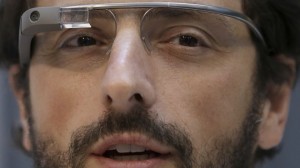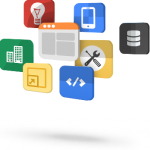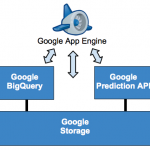As smartphone use becomes prevalent in today’s society, they can not only be used for voice and data communication – later models equipped with Bluetooth LE (Low Energy) can also receive messages over a short range from new Bluetooth LE-equipped devices known as Beacons.
As always Google is on the forefront of Beacon technology, and their new beacon platform enables contextual experiences for users through mobile interactions with Bluetooth Low Energy (BLE) beacons. These beacons are simple, low-power devices which send one-way BLE signals that can be read by nearby Bluetooth-enabled devices.
Beacons can be deployed in fixed places such as businesses, museums, and bus stops, and also on movable objects such as vehicles. Deploying BLE beacons in your venue or attaching them to physical assets that you manage is a good way to give users a location-aware experience via their mobile devices, with contextual and timely information for users which is relevant to their local environment.
Google’s beacon platform consists of several components, starting with the beacon hardware. Lightweight and power-efficient BLE beacons transmit Bluetooth beacon frames, such as Eddystone frames, at a defined interval.
The Proximity Beacon API can be used to register any beacon that supports Eddystone, the iBeacon specification or the AltBeacon specification, so you’ve got a wide range of compatible hardware choices.
The next key component is Google’s Eddystone, an open beacon format that can communicate with Android and iOS devices, aimed at improving interoperable BLE beacon-based applications and services. Eddystone is designed with transparency and robustness in mind, building upon lessons learned from working with industry partners in existing deployments, as well as the wider beacon user community, and it’s released under the Apache 2.0 open-source license.
The Eddystone protocol specification defines a BLE message format for proximity beacon messages, and it describes several different frame types that may be used individually or in combination to create beacons that can be used for a variety of applications.
Different frame types can typically be interleaved by a single beacon, for example 100 transmissions of an Eddystone UID frame for location identification followed by one Eddystone TLM telemetry frame for a health status check, then a repeat of that cycle.
The final key component of the beacon platform is the Proximity Beacon API, which allows you to administer data associated with the beacons that your application uses. The Proximity Beacon API allows you to manage your beacons, register and update beacons, add “attachments” to beacons via the cloud, and monitor the status and health of beacons by monitoring parameters such as battery level.
To make it easy to learn about the Proximity Beacon API and to get started using it, Google provides proximity beacon sample apps for both iOS and Android mobile platforms.
The Proximity Beacon API allows you to manage data associated with your BLE beacons using a REST interface. The Proximity Beacon API allows you to register beacons to the cloud, with beacon attachments hosted on Google’s servers.
After you register a beacon with the Proximity Beacon API you can associate attachments that are stored in the cloud, which means you can manage and update the information associated with each beacon even after the beacons are deployed.
The Proximity Beacon API, in combination with Eddystone’s telemetry broadcast type, helps you to manage your beacons and ensure that your beacon fleet is behaving as it should. Eddystone-TLM frames allow your beacons to report their status to client devices.
For most beacons, these frames are transmitted at regular intervals throughout the device lifetime. You can use the diagnostics and monitoring tools in the Proximity Beacon API to get health statistics from the beacon network and to identify any erroneous behaviours, such as a beacon with a low battery, allowing you to allocate maintenance where it’s needed with beacons in the field, ensuring that your users have a consistently great experience.
You can use attachments to provide data which is specific to one or more beacons, enabling your apps to react to the user’s location. Since attachments are stored in the cloud, the Proximity Beacon API provides a scalable, low-latency way to manage and update the data associated with your deployed beacons, ensuring that your users always see the latest available data and eliminating the need to manually re-provision beacons.
After attachments have been added to beacons using the Proximity Beacon API, you can retrieve them in your app using the Nearby Messages API.
Using Google’s Nearby API, you can extend the functionality of Eddystone and the Google Beacon Platform, allowing your iOS or Android app to detect nearby beacons and execute their attachments, giving users a rich and interactive proximity-based experience.
![]()
Users’ devices can use Bluetooth beacons as a signal to improve other location-based tools, such as the Place Picker, which assists users in selecting nearby locations of interest such as local businesses. With the Nearby API, you can build apps that detect beacons and retrieve messages that you wish to associate with each beacon and process within your app.
Examples could include showing the bus schedule when a user is waiting at a bus stop or providing ticket availability at a theatre kiosk. When you’ve added an attachment to your beacon using the Proximity Beacon API, the Nearby Messages API allows your mobile app to retrieve the attached message or content when the user’s device detects the beacon.
Here at the LX Group we’re ready to partner with you to realise your Beacon requirements, Internet-of-Things ideas and more to bring them to reality. Getting started is easy – click here to contact us, or telephone 1800 810 124.
LX is an award-winning electronics design company based in Sydney, Australia. LX services include full turnkey design, electronics, hardware, software and firmware design. LX specialises in embedded systems and wireless technologies design.
Published by LX Pty Ltd for itself and the LX Group of companies, including LX Design House, LX Solutions and LX Consulting, LX Innovations.





